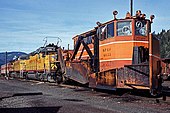Spreader (railroad)
| Jordan Spreader | |
|---|---|
 Former Canadian Pacific Railway Jordan Spreader in the Saskatchewan Railway Museum. | |
| Manufacturer | O.F. Jordan Company |
| Constructed | 1900– |
A spreader is a type of maintenance equipment designed to spread or shape ballast profiles. The spreader spreads gravel along the railroad ties. The various ploughs, wings and blades of specific spreaders allow them to remove snow, build banks, clean and dig ditches, evenly distribute gravel, as well as trim embankments of brush along the side of the track.[1][2][3] Spreaders quickly proved themselves as an extremely economical tool for maintaining trackside drainage ditches and spreading fill dumped beside the track.[4][5]
The operation of the wings was once performed by compressed air and later hydraulics.[6] Besides the MoW-operation, spreaders are also used in open cast mines to clean the tracks from overburden tipped from dump cars.
Jordan spreader history[edit]

The Jordan spreader was the creation of Oswald F. Jordan, a Canadian road master who worked in the Niagara, Ontario area on the Canada Southern Railway, later a subsidiary of the New York Central Railroad. He supervised a crew at the St. Thomas Canada Southern shop in the early 1890s. Jordan's first patent, filed in 1890 and listing Robert Potts as co-inventor, covered a single-blade mechanism with the blade height adjustable with a hand crank and gearing.[7]
Jordan formed his own company, O.F. Jordan Company, in 1898 and continued construction of Jordan Spreaders.[2] By 1906, the company had moved to Chicago, Jordan was a U.S. Citizen, and the spreader was a far more sophisticated device, with blades on both sides of the car, pneumatic power for raising and lowering each blade, and considerably more rugged construction.[8] By 1909, the spreader was being built on a steel-framed car body instead of the wood used in earlier models, and a plow was mounted on the front, with an extension in front of that for shifting material across the track from side to side.[9] Shortly after this, Jordan added a pneumatic system for rapidly and automatically extending and retracting the side blades.[10] At this point, the primary purpose of the Jordan spreader was spreading ballast along the tracks.
Following Jordan's death in 1910, Walter Riley took over management of the company and directed it for the next 50 years. Over the years that followed, the Jordan spreader was developed into a multi-purpose MoW vehicle with adjustable blades and ploughs added to the wings.[11] New uses included trackside ditch maintenance and spreading fill dumped beside the track.[12] Over 1,400 spreaders were built. Jordan spreaders are available by special order from Harsco Rail.[13]

In 2001, the Jordan Spreader was inducted into the North America Railway Hall of Fame in the "Local:Technical Innovation" category.[14] It shared this selection with another technical innovation, the rotary snowplow.
References[edit]
- ^ "Welcome to Saskrailmuseum.org". Jordan Spreader 402871. September 11, 2008. Archived from the original on October 15, 2008. Retrieved 2008-10-03.
- ^ a b "BRS Canadian Pacific Railway Jordan Spreader No. 402818". September 11, 2008. Archived from the original on April 13, 2008. Retrieved 2008-10-03.
- ^ "NAR Work Train". The Alberta Pioneer Railway Association. 2007. Retrieved 2008-10-03.
- ^ Halbert Powers Gillette, Chapter X: Methods and Cost with Cars, Earthwork and Its Cost, McGraw Hill, New York, 1920; pages 384-386.
- ^ Pinkepank, Jerry A. (June 1969). "Mr. Jordan's marvelous multidexterous machine". Trains. No. 6. A.C. Kalmbach. pp. 38–42a.
- ^ "1920's - Railway Jordan Spreader Controls". Yahoo!. May 24, 2008. Retrieved 2008-10-03.
- ^ Oswald Jordan and Robert Potts, Railroad Scraper, U.S. patent 447,777, granted March 10, 1891.
- ^ Oswald Jordan, Railroad Spreader, U.S. patent 852,880, granted May 7, 1907.
- ^ Oswald Jordan, Railroad Spreader, U.S. patent 963,773, granted July 12, 1910.
- ^ Oswald Jordan, Railroad Spreader, U.S. patent 996,256, granted June 27, 1911.
- ^ Harry Protzeller, Railroad Spreader, U.S. patent 1,816,869, granted August 4, 1931.
- ^ Halbert Powers Gillette, Chapter X: Methods and Cost with Cars, Earthwork and Its Cost, McGraw Hill, New York, 1920; pages 384-386.
- ^ "Jordan Spreader". North America Railway Hall of Fame. Retrieved 2016-02-11.
- ^ North America Railway Hall of Fame. "Jordan Spreader". narhf.org. Archived from the original on 14 April 2014. Retrieved 9 December 2023.
